BSBSTR601: Innovation & Continuous Improvement Knowledge Test
VerifiedAdded on 2023/06/10
|7
|2003
|118
Homework Assignment
AI Summary
This BSBSTR601 assignment solution addresses key knowledge questions related to managing innovation and continuous improvement within an organization. It covers topics such as cost-benefit analysis methods, barriers to productivity improvement due to ineffective knowledge management, principles for evaluating continuous improvement systems, creativity theories and their application, diffusion of innovation theory, the concept of a learning organization, quality management and continuous improvement theories, Kotter’s 8-Step change model, ISO 9000 standards, risk management as per AS/NZS ISO 31000:2009, supply chain dynamics, gap analysis for assessing creative culture, and sustainability practices in Australian workplaces. The solution provides detailed explanations and examples for each question, offering a comprehensive understanding of the subject matter. Desklib provides this assignment as a resource for students, along with a wealth of other solved assignments and past papers.

BSBSTR601 Manage innovation and continuous improvement
Task 1 – Knowledge Questions
Task summary
This is an open book knowledge test, to be completed in your own time.
You need to answer all the written questions correctly.
Required
Access to textbooks/other learning materials.
Access to a computer and Microsoft Office.
Access to the internet.
Timing
Your assessor will advise you of the due date of this assessment via Canvas.
Submit onto Canvas
This completed workbook
Assessment criteria
All questions must be answered correctly for you to be assessed as having completed the task
satisfactorily.
Re-submission opportunities
You will be provided feedback on your performance by the Assessor via Canvas. The feedback will
indicate if you have satisfactorily addressed the requirements of each part of this task.
If any parts of the task are not satisfactorily completed, the assessor will provide you written
feedback along with guidance on what you must undertake to demonstrate satisfactory
performance. Re-assessment attempt(s) will be arranged at a later time and date.
You have the right to appeal the outcome of assessment decisions if you feel that you have been
dealt with unfairly or have other appropriate grounds for an appeal.
You are encouraged to consult with the assessor prior to attempting this task if you do not
understand any part of this task or if you have any learning issues or needs that may hinder you
when attempting any part of the assessment.
Assessment Cover Sheet
Candidate name:
Candidate ID
Task 1 – Knowledge Questions
Task summary
This is an open book knowledge test, to be completed in your own time.
You need to answer all the written questions correctly.
Required
Access to textbooks/other learning materials.
Access to a computer and Microsoft Office.
Access to the internet.
Timing
Your assessor will advise you of the due date of this assessment via Canvas.
Submit onto Canvas
This completed workbook
Assessment criteria
All questions must be answered correctly for you to be assessed as having completed the task
satisfactorily.
Re-submission opportunities
You will be provided feedback on your performance by the Assessor via Canvas. The feedback will
indicate if you have satisfactorily addressed the requirements of each part of this task.
If any parts of the task are not satisfactorily completed, the assessor will provide you written
feedback along with guidance on what you must undertake to demonstrate satisfactory
performance. Re-assessment attempt(s) will be arranged at a later time and date.
You have the right to appeal the outcome of assessment decisions if you feel that you have been
dealt with unfairly or have other appropriate grounds for an appeal.
You are encouraged to consult with the assessor prior to attempting this task if you do not
understand any part of this task or if you have any learning issues or needs that may hinder you
when attempting any part of the assessment.
Assessment Cover Sheet
Candidate name:
Candidate ID
Paraphrase This Document
Need a fresh take? Get an instant paraphrase of this document with our AI Paraphraser
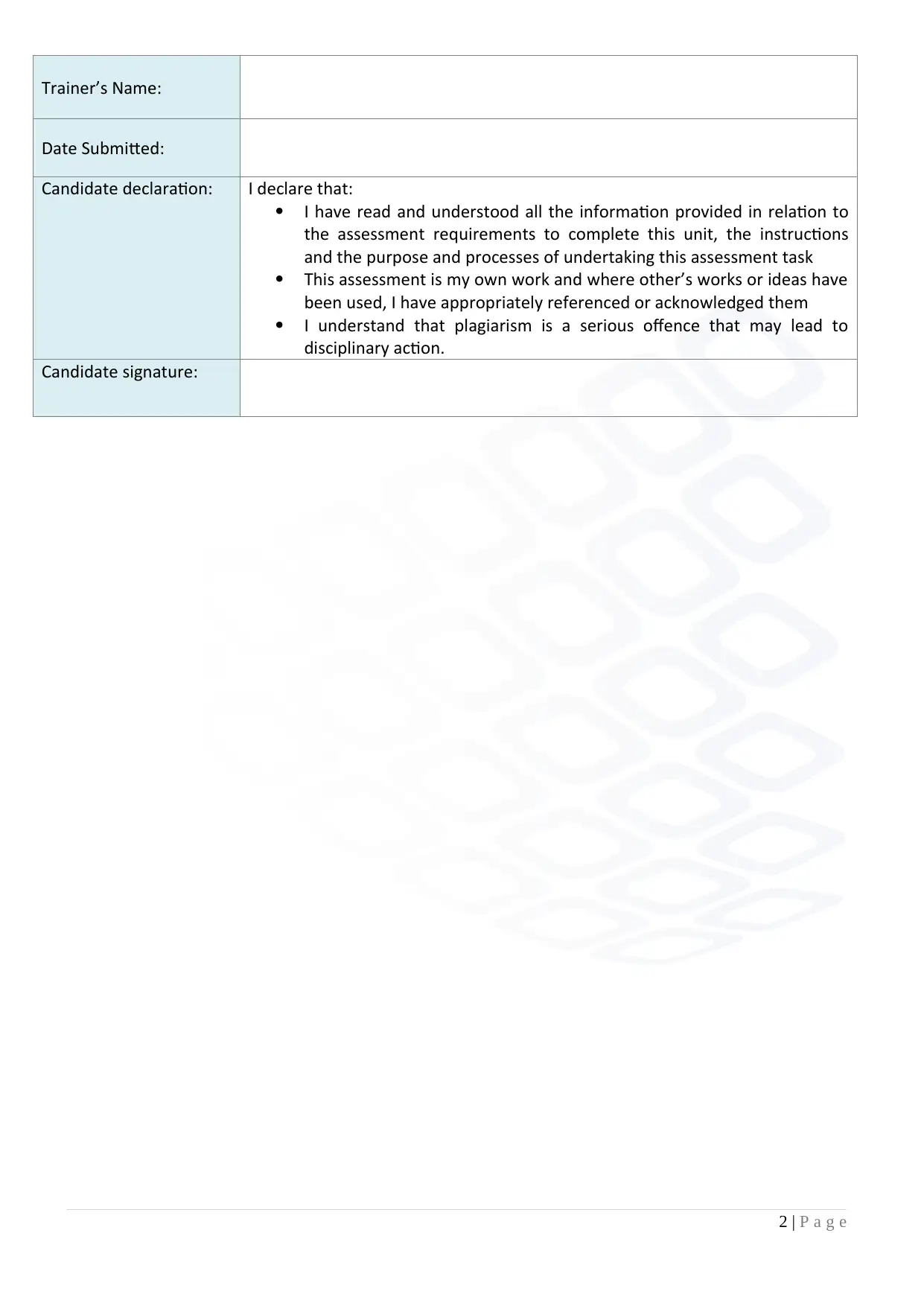
Trainer’s Name:
Date Submitted:
Candidate declaration: I declare that:
I have read and understood all the information provided in relation to
the assessment requirements to complete this unit, the instructions
and the purpose and processes of undertaking this assessment task
This assessment is my own work and where other’s works or ideas have
been used, I have appropriately referenced or acknowledged them
I understand that plagiarism is a serious offence that may lead to
disciplinary action.
Candidate signature:
2 | P a g e
Date Submitted:
Candidate declaration: I declare that:
I have read and understood all the information provided in relation to
the assessment requirements to complete this unit, the instructions
and the purpose and processes of undertaking this assessment task
This assessment is my own work and where other’s works or ideas have
been used, I have appropriately referenced or acknowledged them
I understand that plagiarism is a serious offence that may lead to
disciplinary action.
Candidate signature:
2 | P a g e
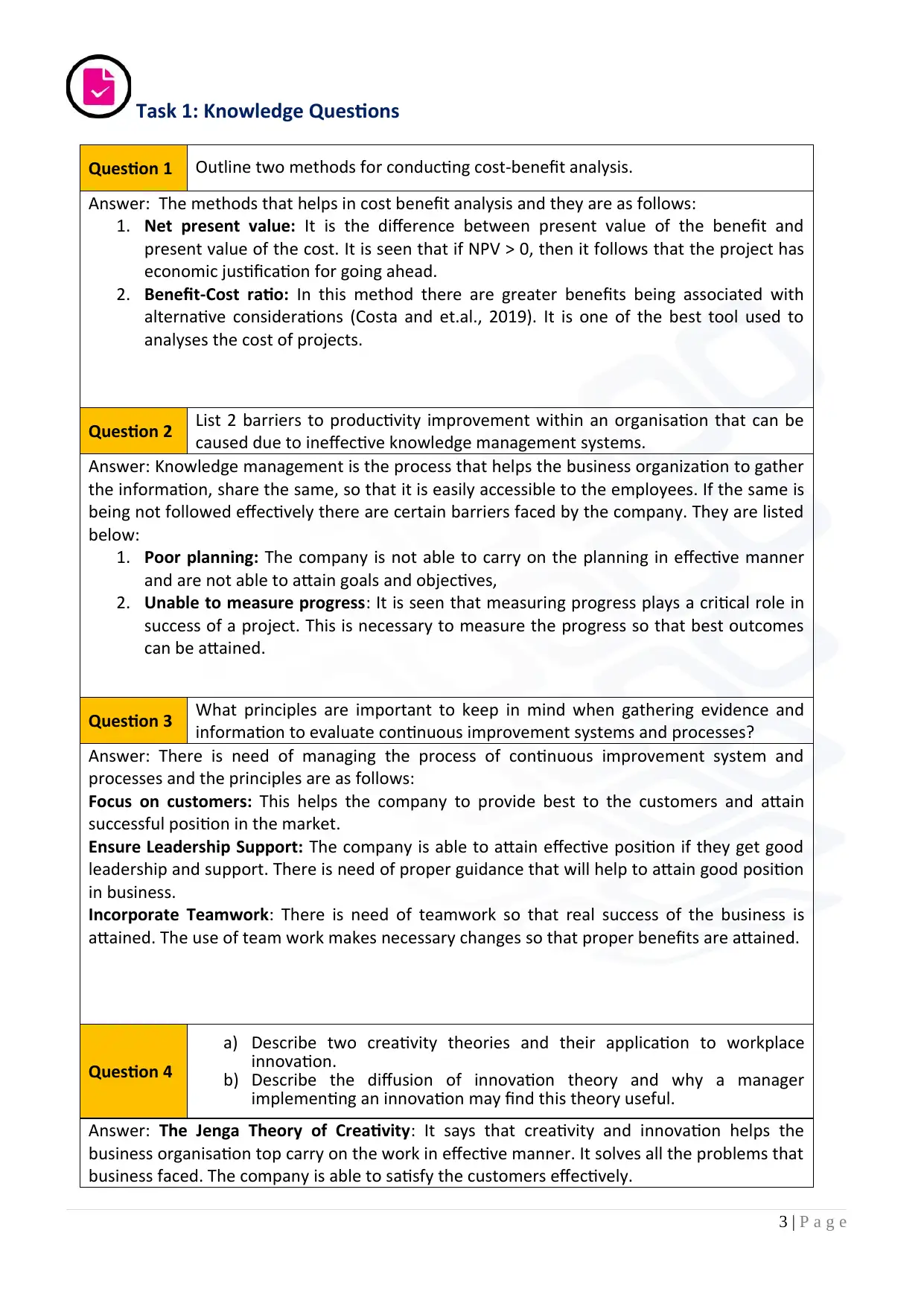
Task 1: Knowledge Questions
Question 1 Outline two methods for conducting cost-benefit analysis.
Answer: The methods that helps in cost benefit analysis and they are as follows:
1. Net present value: It is the difference between present value of the benefit and
present value of the cost. It is seen that if NPV > 0, then it follows that the project has
economic justification for going ahead.
2. Benefit-Cost ratio: In this method there are greater benefits being associated with
alternative considerations (Costa and et.al., 2019). It is one of the best tool used to
analyses the cost of projects.
Question 2 List 2 barriers to productivity improvement within an organisation that can be
caused due to ineffective knowledge management systems.
Answer: Knowledge management is the process that helps the business organization to gather
the information, share the same, so that it is easily accessible to the employees. If the same is
being not followed effectively there are certain barriers faced by the company. They are listed
below:
1. Poor planning: The company is not able to carry on the planning in effective manner
and are not able to attain goals and objectives,
2. Unable to measure progress: It is seen that measuring progress plays a critical role in
success of a project. This is necessary to measure the progress so that best outcomes
can be attained.
Question 3 What principles are important to keep in mind when gathering evidence and
information to evaluate continuous improvement systems and processes?
Answer: There is need of managing the process of continuous improvement system and
processes and the principles are as follows:
Focus on customers: This helps the company to provide best to the customers and attain
successful position in the market.
Ensure Leadership Support: The company is able to attain effective position if they get good
leadership and support. There is need of proper guidance that will help to attain good position
in business.
Incorporate Teamwork: There is need of teamwork so that real success of the business is
attained. The use of team work makes necessary changes so that proper benefits are attained.
Question 4
a) Describe two creativity theories and their application to workplace
innovation.
b) Describe the diffusion of innovation theory and why a manager
implementing an innovation may find this theory useful.
Answer: The Jenga Theory of Creativity: It says that creativity and innovation helps the
business organisation top carry on the work in effective manner. It solves all the problems that
business faced. The company is able to satisfy the customers effectively.
3 | P a g e
Question 1 Outline two methods for conducting cost-benefit analysis.
Answer: The methods that helps in cost benefit analysis and they are as follows:
1. Net present value: It is the difference between present value of the benefit and
present value of the cost. It is seen that if NPV > 0, then it follows that the project has
economic justification for going ahead.
2. Benefit-Cost ratio: In this method there are greater benefits being associated with
alternative considerations (Costa and et.al., 2019). It is one of the best tool used to
analyses the cost of projects.
Question 2 List 2 barriers to productivity improvement within an organisation that can be
caused due to ineffective knowledge management systems.
Answer: Knowledge management is the process that helps the business organization to gather
the information, share the same, so that it is easily accessible to the employees. If the same is
being not followed effectively there are certain barriers faced by the company. They are listed
below:
1. Poor planning: The company is not able to carry on the planning in effective manner
and are not able to attain goals and objectives,
2. Unable to measure progress: It is seen that measuring progress plays a critical role in
success of a project. This is necessary to measure the progress so that best outcomes
can be attained.
Question 3 What principles are important to keep in mind when gathering evidence and
information to evaluate continuous improvement systems and processes?
Answer: There is need of managing the process of continuous improvement system and
processes and the principles are as follows:
Focus on customers: This helps the company to provide best to the customers and attain
successful position in the market.
Ensure Leadership Support: The company is able to attain effective position if they get good
leadership and support. There is need of proper guidance that will help to attain good position
in business.
Incorporate Teamwork: There is need of teamwork so that real success of the business is
attained. The use of team work makes necessary changes so that proper benefits are attained.
Question 4
a) Describe two creativity theories and their application to workplace
innovation.
b) Describe the diffusion of innovation theory and why a manager
implementing an innovation may find this theory useful.
Answer: The Jenga Theory of Creativity: It says that creativity and innovation helps the
business organisation top carry on the work in effective manner. It solves all the problems that
business faced. The company is able to satisfy the customers effectively.
3 | P a g e
⊘ This is a preview!⊘
Do you want full access?
Subscribe today to unlock all pages.

Trusted by 1+ million students worldwide
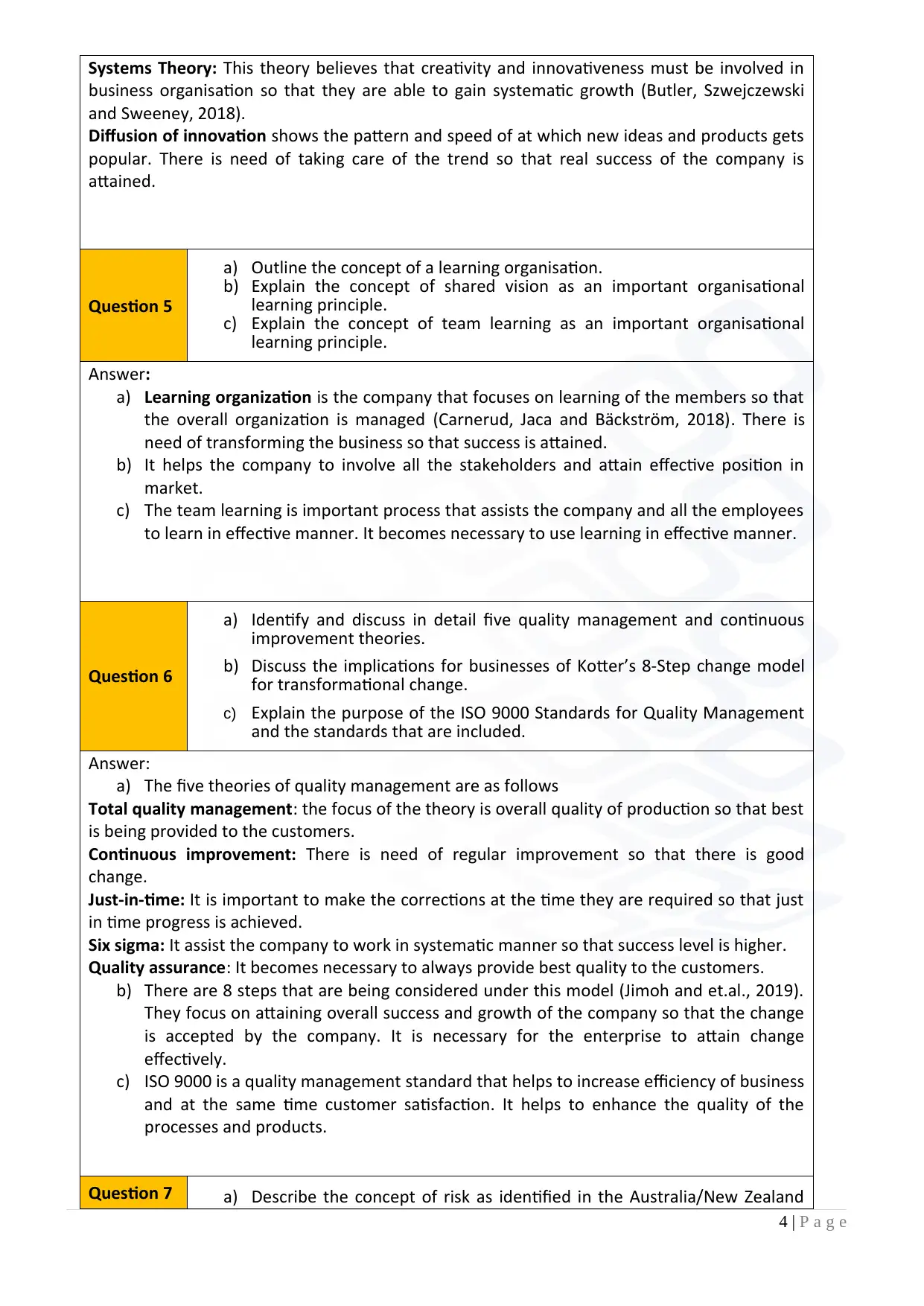
Systems Theory: This theory believes that creativity and innovativeness must be involved in
business organisation so that they are able to gain systematic growth (Butler, Szwejczewski
and Sweeney, 2018).
Diffusion of innovation shows the pattern and speed of at which new ideas and products gets
popular. There is need of taking care of the trend so that real success of the company is
attained.
Question 5
a) Outline the concept of a learning organisation.
b) Explain the concept of shared vision as an important organisational
learning principle.
c) Explain the concept of team learning as an important organisational
learning principle.
Answer:
a) Learning organization is the company that focuses on learning of the members so that
the overall organization is managed (Carnerud, Jaca and Bäckström, 2018). There is
need of transforming the business so that success is attained.
b) It helps the company to involve all the stakeholders and attain effective position in
market.
c) The team learning is important process that assists the company and all the employees
to learn in effective manner. It becomes necessary to use learning in effective manner.
Question 6
a) Identify and discuss in detail five quality management and continuous
improvement theories.
b) Discuss the implications for businesses of Kotter’s 8-Step change model
for transformational change.
c) Explain the purpose of the ISO 9000 Standards for Quality Management
and the standards that are included.
Answer:
a) The five theories of quality management are as follows
Total quality management: the focus of the theory is overall quality of production so that best
is being provided to the customers.
Continuous improvement: There is need of regular improvement so that there is good
change.
Just-in-time: It is important to make the corrections at the time they are required so that just
in time progress is achieved.
Six sigma: It assist the company to work in systematic manner so that success level is higher.
Quality assurance: It becomes necessary to always provide best quality to the customers.
b) There are 8 steps that are being considered under this model (Jimoh and et.al., 2019).
They focus on attaining overall success and growth of the company so that the change
is accepted by the company. It is necessary for the enterprise to attain change
effectively.
c) ISO 9000 is a quality management standard that helps to increase efficiency of business
and at the same time customer satisfaction. It helps to enhance the quality of the
processes and products.
Question 7 a) Describe the concept of risk as identified in the Australia/New Zealand
4 | P a g e
business organisation so that they are able to gain systematic growth (Butler, Szwejczewski
and Sweeney, 2018).
Diffusion of innovation shows the pattern and speed of at which new ideas and products gets
popular. There is need of taking care of the trend so that real success of the company is
attained.
Question 5
a) Outline the concept of a learning organisation.
b) Explain the concept of shared vision as an important organisational
learning principle.
c) Explain the concept of team learning as an important organisational
learning principle.
Answer:
a) Learning organization is the company that focuses on learning of the members so that
the overall organization is managed (Carnerud, Jaca and Bäckström, 2018). There is
need of transforming the business so that success is attained.
b) It helps the company to involve all the stakeholders and attain effective position in
market.
c) The team learning is important process that assists the company and all the employees
to learn in effective manner. It becomes necessary to use learning in effective manner.
Question 6
a) Identify and discuss in detail five quality management and continuous
improvement theories.
b) Discuss the implications for businesses of Kotter’s 8-Step change model
for transformational change.
c) Explain the purpose of the ISO 9000 Standards for Quality Management
and the standards that are included.
Answer:
a) The five theories of quality management are as follows
Total quality management: the focus of the theory is overall quality of production so that best
is being provided to the customers.
Continuous improvement: There is need of regular improvement so that there is good
change.
Just-in-time: It is important to make the corrections at the time they are required so that just
in time progress is achieved.
Six sigma: It assist the company to work in systematic manner so that success level is higher.
Quality assurance: It becomes necessary to always provide best quality to the customers.
b) There are 8 steps that are being considered under this model (Jimoh and et.al., 2019).
They focus on attaining overall success and growth of the company so that the change
is accepted by the company. It is necessary for the enterprise to attain change
effectively.
c) ISO 9000 is a quality management standard that helps to increase efficiency of business
and at the same time customer satisfaction. It helps to enhance the quality of the
processes and products.
Question 7 a) Describe the concept of risk as identified in the Australia/New Zealand
4 | P a g e
Paraphrase This Document
Need a fresh take? Get an instant paraphrase of this document with our AI Paraphraser
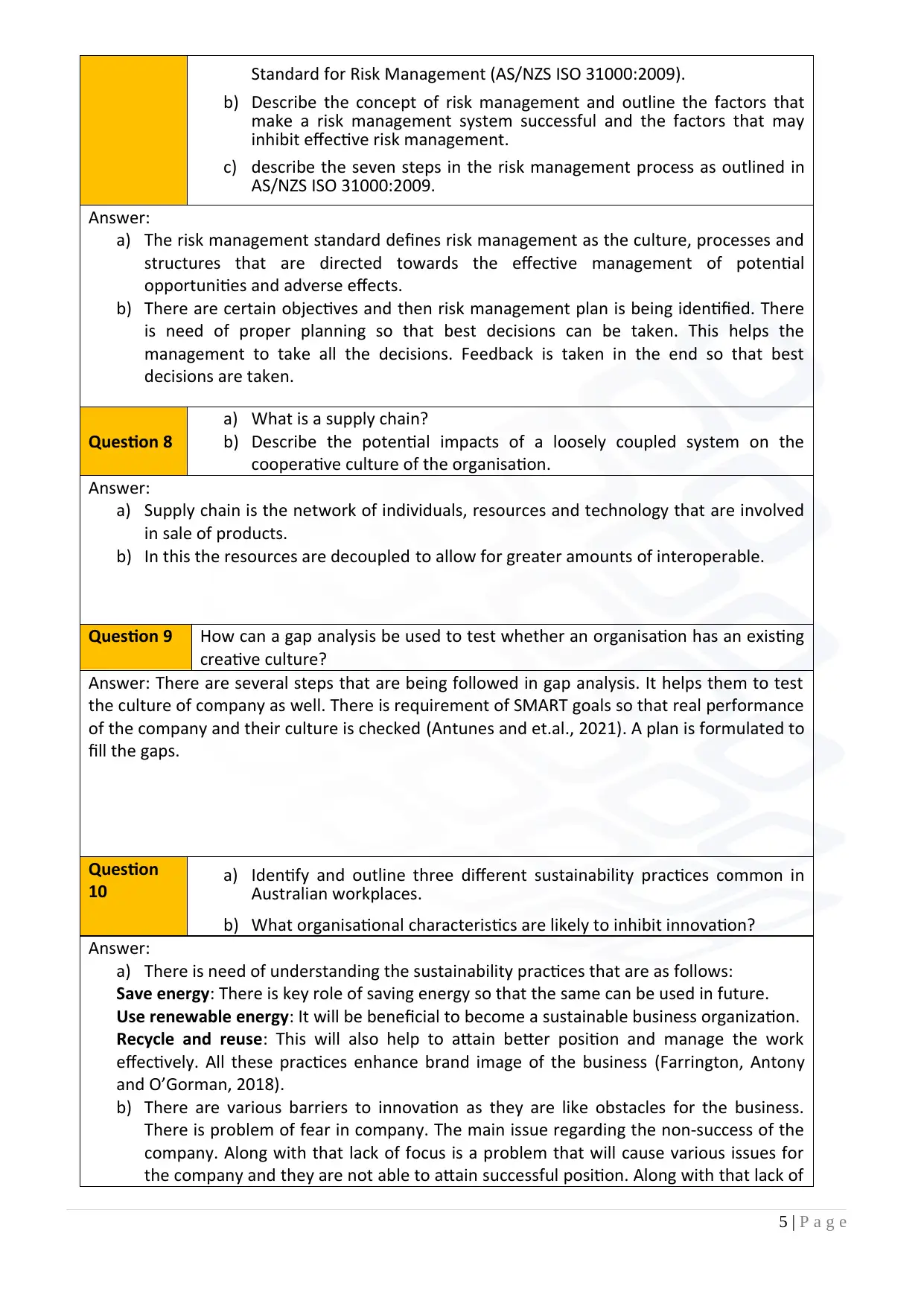
Standard for Risk Management (AS/NZS ISO 31000:2009).
b) Describe the concept of risk management and outline the factors that
make a risk management system successful and the factors that may
inhibit effective risk management.
c) describe the seven steps in the risk management process as outlined in
AS/NZS ISO 31000:2009.
Answer:
a) The risk management standard defines risk management as the culture, processes and
structures that are directed towards the effective management of potential
opportunities and adverse effects.
b) There are certain objectives and then risk management plan is being identified. There
is need of proper planning so that best decisions can be taken. This helps the
management to take all the decisions. Feedback is taken in the end so that best
decisions are taken.
Question 8
a) What is a supply chain?
b) Describe the potential impacts of a loosely coupled system on the
cooperative culture of the organisation.
Answer:
a) Supply chain is the network of individuals, resources and technology that are involved
in sale of products.
b) In this the resources are decoupled to allow for greater amounts of interoperable.
Question 9 How can a gap analysis be used to test whether an organisation has an existing
creative culture?
Answer: There are several steps that are being followed in gap analysis. It helps them to test
the culture of company as well. There is requirement of SMART goals so that real performance
of the company and their culture is checked (Antunes and et.al., 2021). A plan is formulated to
fill the gaps.
Question
10 a) Identify and outline three different sustainability practices common in
Australian workplaces.
b) What organisational characteristics are likely to inhibit innovation?
Answer:
a) There is need of understanding the sustainability practices that are as follows:
Save energy: There is key role of saving energy so that the same can be used in future.
Use renewable energy: It will be beneficial to become a sustainable business organization.
Recycle and reuse: This will also help to attain better position and manage the work
effectively. All these practices enhance brand image of the business (Farrington, Antony
and O’Gorman, 2018).
b) There are various barriers to innovation as they are like obstacles for the business.
There is problem of fear in company. The main issue regarding the non-success of the
company. Along with that lack of focus is a problem that will cause various issues for
the company and they are not able to attain successful position. Along with that lack of
5 | P a g e
b) Describe the concept of risk management and outline the factors that
make a risk management system successful and the factors that may
inhibit effective risk management.
c) describe the seven steps in the risk management process as outlined in
AS/NZS ISO 31000:2009.
Answer:
a) The risk management standard defines risk management as the culture, processes and
structures that are directed towards the effective management of potential
opportunities and adverse effects.
b) There are certain objectives and then risk management plan is being identified. There
is need of proper planning so that best decisions can be taken. This helps the
management to take all the decisions. Feedback is taken in the end so that best
decisions are taken.
Question 8
a) What is a supply chain?
b) Describe the potential impacts of a loosely coupled system on the
cooperative culture of the organisation.
Answer:
a) Supply chain is the network of individuals, resources and technology that are involved
in sale of products.
b) In this the resources are decoupled to allow for greater amounts of interoperable.
Question 9 How can a gap analysis be used to test whether an organisation has an existing
creative culture?
Answer: There are several steps that are being followed in gap analysis. It helps them to test
the culture of company as well. There is requirement of SMART goals so that real performance
of the company and their culture is checked (Antunes and et.al., 2021). A plan is formulated to
fill the gaps.
Question
10 a) Identify and outline three different sustainability practices common in
Australian workplaces.
b) What organisational characteristics are likely to inhibit innovation?
Answer:
a) There is need of understanding the sustainability practices that are as follows:
Save energy: There is key role of saving energy so that the same can be used in future.
Use renewable energy: It will be beneficial to become a sustainable business organization.
Recycle and reuse: This will also help to attain better position and manage the work
effectively. All these practices enhance brand image of the business (Farrington, Antony
and O’Gorman, 2018).
b) There are various barriers to innovation as they are like obstacles for the business.
There is problem of fear in company. The main issue regarding the non-success of the
company. Along with that lack of focus is a problem that will cause various issues for
the company and they are not able to attain successful position. Along with that lack of
5 | P a g e
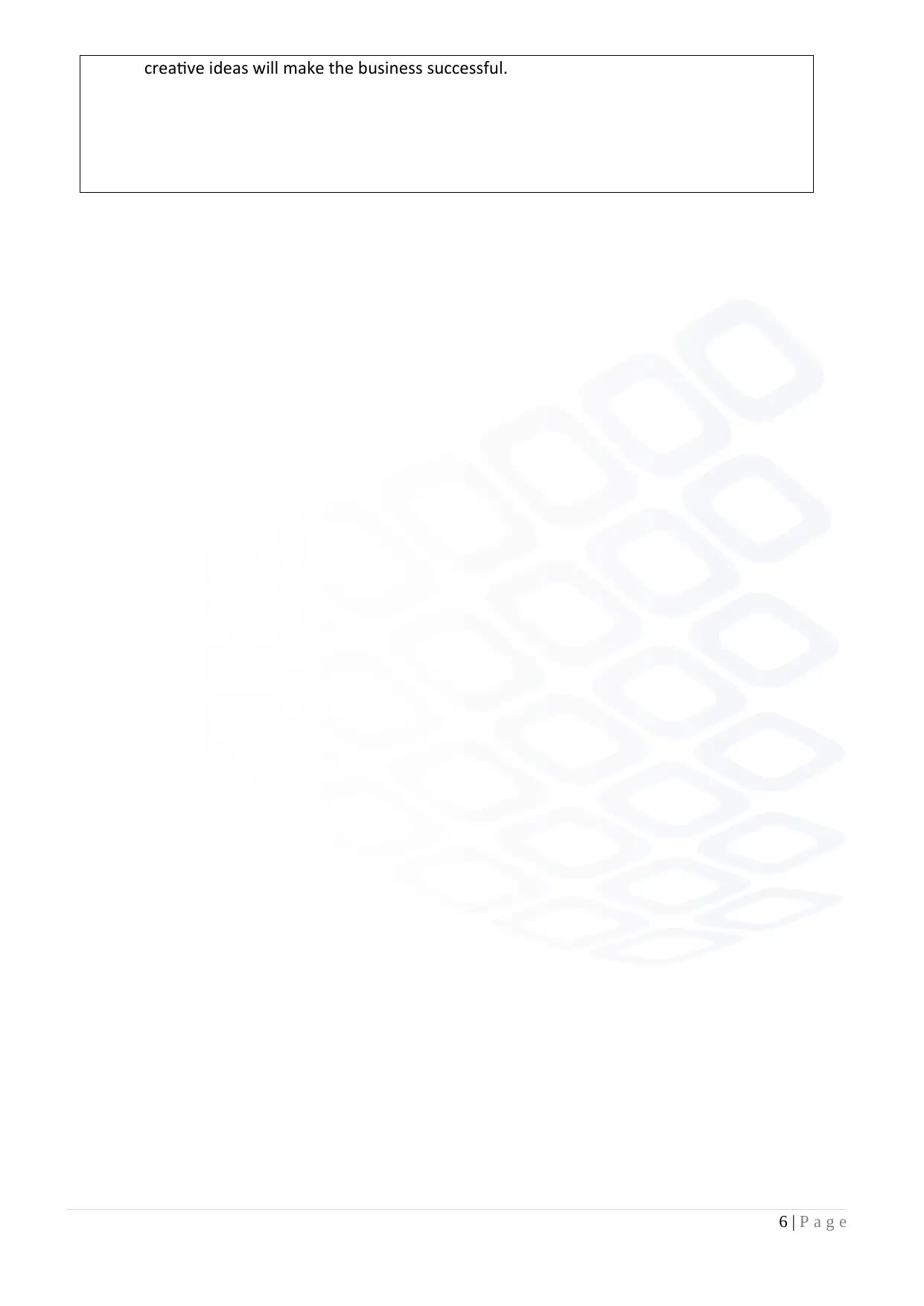
creative ideas will make the business successful.
6 | P a g e
6 | P a g e
⊘ This is a preview!⊘
Do you want full access?
Subscribe today to unlock all pages.

Trusted by 1+ million students worldwide
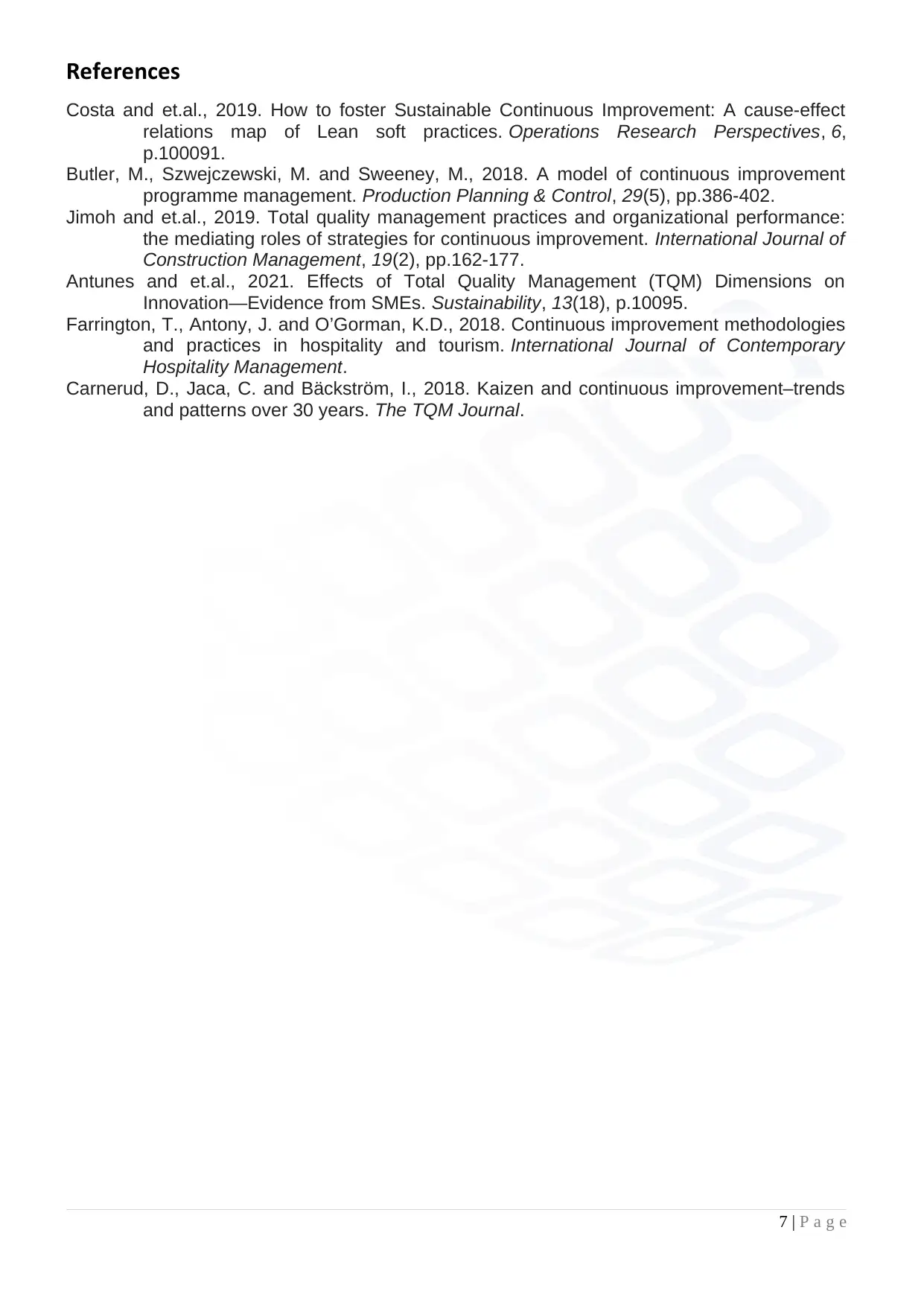
References
Costa and et.al., 2019. How to foster Sustainable Continuous Improvement: A cause-effect
relations map of Lean soft practices. Operations Research Perspectives, 6,
p.100091.
Butler, M., Szwejczewski, M. and Sweeney, M., 2018. A model of continuous improvement
programme management. Production Planning & Control, 29(5), pp.386-402.
Jimoh and et.al., 2019. Total quality management practices and organizational performance:
the mediating roles of strategies for continuous improvement. International Journal of
Construction Management, 19(2), pp.162-177.
Antunes and et.al., 2021. Effects of Total Quality Management (TQM) Dimensions on
Innovation—Evidence from SMEs. Sustainability, 13(18), p.10095.
Farrington, T., Antony, J. and O’Gorman, K.D., 2018. Continuous improvement methodologies
and practices in hospitality and tourism. International Journal of Contemporary
Hospitality Management.
Carnerud, D., Jaca, C. and Bäckström, I., 2018. Kaizen and continuous improvement–trends
and patterns over 30 years. The TQM Journal.
7 | P a g e
Costa and et.al., 2019. How to foster Sustainable Continuous Improvement: A cause-effect
relations map of Lean soft practices. Operations Research Perspectives, 6,
p.100091.
Butler, M., Szwejczewski, M. and Sweeney, M., 2018. A model of continuous improvement
programme management. Production Planning & Control, 29(5), pp.386-402.
Jimoh and et.al., 2019. Total quality management practices and organizational performance:
the mediating roles of strategies for continuous improvement. International Journal of
Construction Management, 19(2), pp.162-177.
Antunes and et.al., 2021. Effects of Total Quality Management (TQM) Dimensions on
Innovation—Evidence from SMEs. Sustainability, 13(18), p.10095.
Farrington, T., Antony, J. and O’Gorman, K.D., 2018. Continuous improvement methodologies
and practices in hospitality and tourism. International Journal of Contemporary
Hospitality Management.
Carnerud, D., Jaca, C. and Bäckström, I., 2018. Kaizen and continuous improvement–trends
and patterns over 30 years. The TQM Journal.
7 | P a g e
1 out of 7
Related Documents
Your All-in-One AI-Powered Toolkit for Academic Success.
+13062052269
info@desklib.com
Available 24*7 on WhatsApp / Email
![[object Object]](/_next/static/media/star-bottom.7253800d.svg)
Unlock your academic potential
Copyright © 2020–2025 A2Z Services. All Rights Reserved. Developed and managed by ZUCOL.





